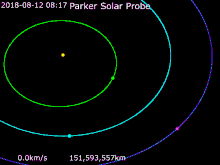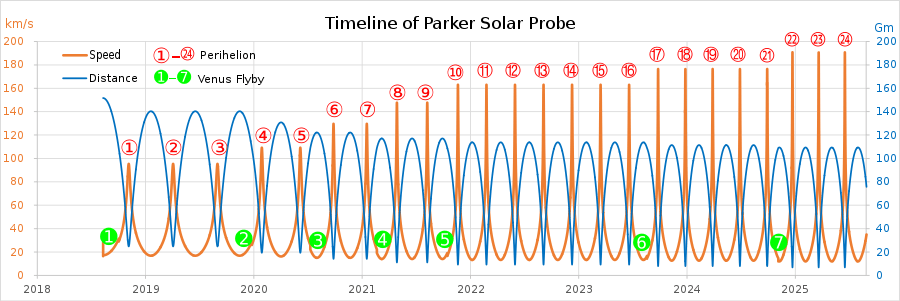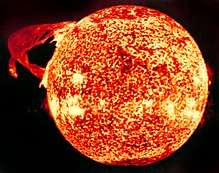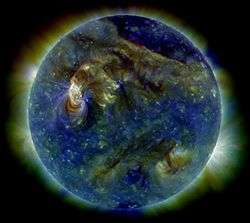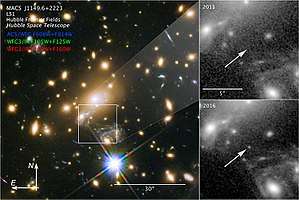Parker Solar Probe
The Parker Solar Probe (abbreviated PSP; previously Solar Probe, Solar Probe Plus or Solar Probe+)[8] is a NASA robotic spacecraft launched in 2018 with the mission of making observations of the outer corona of the Sun.[3][6][9] It will approach to within 9.86 solar radii (6.9 million km or 4.3 million miles)[10][11] from the center of the Sun, and by 2025 will travel, at closest approach, as fast as 690,000 km/h (430,000 mph), or 0.064% the speed of light.[10][12]
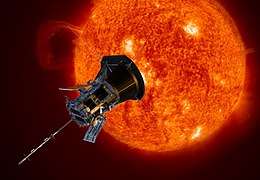 An artistic rendition of the Parker Solar Probe. | |||||||||||||||
| Names | Solar Probe (before 2002) Solar Probe Plus (2010–2017) Parker Solar Probe (since 2017) | ||||||||||||||
|---|---|---|---|---|---|---|---|---|---|---|---|---|---|---|---|
| Mission type | Heliophysics | ||||||||||||||
| Operator | NASA / Applied Physics Laboratory | ||||||||||||||
| COSPAR ID | 2018-065A | ||||||||||||||
| SATCAT no. | 43592 | ||||||||||||||
| Website | parkersolarprobe | ||||||||||||||
| Mission duration | 7 years (nominal mission) Elapsed: 2 years and 2 days | ||||||||||||||
| Spacecraft properties | |||||||||||||||
| Manufacturer | Applied Physics Laboratory | ||||||||||||||
| Launch mass | 685 kg (1,510 lb)[1] | ||||||||||||||
| Dry mass | 555 kg (1,224 lb) | ||||||||||||||
| Payload mass | 50 kg (110 lb) | ||||||||||||||
| Dimensions | 1.0 m × 3.0 m × 2.3 m (3.3 ft × 9.8 ft × 7.5 ft) | ||||||||||||||
| Power | 343 W (at closest approach) | ||||||||||||||
| Start of mission | |||||||||||||||
| Launch date | August 12, 2018, 07:31 UTC[2][3][4] | ||||||||||||||
| Rocket | Delta IV Heavy / Star-48BV[5] | ||||||||||||||
| Launch site | Cape Canaveral, SLC-37 | ||||||||||||||
| Contractor | United Launch Alliance | ||||||||||||||
| Orbital parameters | |||||||||||||||
| Reference system | Heliocentric | ||||||||||||||
| Semi-major axis | 0.388 AU (58.0 million km; 36.1 million mi) | ||||||||||||||
| Perihelion altitude | 0.046 AU (6.9 million km; 4.3 million mi; 9.86 R☉)[note 1] | ||||||||||||||
| Aphelion altitude | 0.73 AU (109 million km; 68 million mi)[6] | ||||||||||||||
| Inclination | 3.4° | ||||||||||||||
| Period | 88 days | ||||||||||||||
| Sun | |||||||||||||||
| Transponders | |||||||||||||||
| Band | Ka-band X-band | ||||||||||||||
| |||||||||||||||
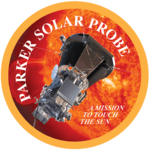 The official insignia for the Parker Solar Probe mission. | |||||||||||||||
The project was announced in the fiscal 2009 budget year. The cost of the project is US$1.5 billion. Johns Hopkins University Applied Physics Laboratory designed and built the spacecraft,[13] which was launched on August 12, 2018.[2] It became the first NASA spacecraft named after a living person, honoring physicist Eugene Newman Parker, professor emeritus at the University of Chicago.[14]
A memory card containing the names of over 1.1 million people was mounted on a plaque and installed below the spacecraft's high-gain antenna on May 18, 2018.[15] The card also contains photos of Parker and a copy of his 1958 scientific paper predicting important aspects of solar physics.[16]
On October 29, 2018, at about 18:04 UTC, the spacecraft became the closest ever artificial object to the Sun. The previous record, 42.73 million kilometres (26.55×106 mi) from the Sun's surface, was set by the Helios 2 spacecraft in April 1976.[17] As of its perihelion on January 29, 2020, the Parker Solar Probe's closest approach is 18.7 million kilometres (11.6×106 mi).[18] This will be surpassed after each successive flyby of Venus.
History
.jpg)
The Parker Solar Probe concept originates in the 1958 report by the Fields and Particles Group (Committee 8 of the National Academy of Sciences' Space Science Board [19][20]) which proposed several space missions including "a solar probe to pass inside the orbit of Mercury to study the particles and fields in the vicinity of the Sun".[21][22] Studies in the 1970s and 80s reaffirmed its importance,[21] but it was always postponed due to cost. A cost-reduced Solar Orbiter mission was studied in the 1990s, and a more capable Solar Probe mission served as one of the centerpieces of the eponymous Outer Planet/Solar Probe (OPSP) program formulated by NASA in the late 1990s. The first three missions of the program were planned to be: the Solar Orbiter, the Pluto and Kuiper belt reconnaissance mission Pluto Kuiper Express, and the Europa Orbiter astrobiology mission focused on Europa.[23][24]
The original Solar Probe design used a gravity assist from Jupiter to enter a polar orbit which dropped almost directly toward the Sun. While this explored the important solar poles and came even closer to the surface (3 R☉, a perihelion of 4 R☉),[24] the extreme variation in solar irradiance made for an expensive mission and required a radioisotope thermal generator for power. The trip to Jupiter also made for a long mission (3 1⁄2 years to first solar perihelion, 8 years to second).
Following the appointment of Sean O'Keefe as Administrator of NASA, the entirety of the OPSP program was canceled as part of President George W. Bush's request for the 2003 United States federal budget.[25] Administrator O'Keefe cited a need for a restructuring of NASA and its projects, falling in line with the Bush Administration's wish for NASA to refocus on "research and development, and addressing management shortcomings".[25]
The cancellation of the program also resulted in the initial cancellation of New Horizons, the mission that eventually won the competition to replace Pluto Kuiper Express in the former OPSP program.[26] That mission, which would eventually be launched as the first mission of the New Frontiers program, a conceptual successor to the OPSP program, would undergo a lengthy political battle to secure funding for its launch, which occurred in 2006.[27]
In the early 2010s, plans for the Solar Probe mission were incorporated into a lower-cost Solar Probe Plus.[28] The redesigned mission uses multiple Venus gravity assists for a more direct flight path, which can be powered by solar panels. It also has a higher perihelion, reducing the demands on the thermal protection system.
In May 2017, the spacecraft was renamed Parker Solar Probe in honor of astrophysicist Eugene Newman Parker,[29][30] who coined the term "solar wind". The solar probe cost NASA US$1.5 billion.[31][32] The launch rocket bore a dedication in memory of APL engineer Andrew A. Dantzler who had worked on the project.[33]
Spacecraft
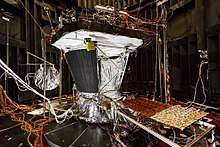
The Parker Solar Probe is the first spacecraft to fly into the low solar corona. It will assess the structure and dynamics of the Sun's coronal plasma and magnetic field, the energy flow that heats the solar corona and impels the solar wind, and the mechanisms that accelerate energetic particles.
The spacecraft's systems are protected from the extreme heat and radiation near the Sun by a solar shield. Incident solar radiation at perihelion is approximately 650 kW/m2, or 475 times the intensity at Earth orbit.[1][34]:31 The solar shield is hexagonal, mounted on the Sun-facing side of the spacecraft, 2.3 m (7.5 ft) in diameter,[35] 11.4 cm (4.5 in) thick, and is made of reinforced carbon–carbon composite, which is designed to withstand temperatures outside the spacecraft of about 1,370 °C (2,500 °F).[1]
A white reflective alumina surface layer minimizes absorption. The spacecraft systems and scientific instruments are located in the central portion of the shield's shadow, where direct radiation from the Sun is fully blocked. If the shield were not between the spacecraft and the Sun, the probe would be damaged and become inoperative within tens of seconds. As radio communication with Earth will take about eight minutes in each direction, the Parker Solar Probe will have to act autonomously and rapidly to protect itself. This will be done using four light sensors to detect the first traces of direct sunlight coming from the shield limits and engaging movements from reaction wheels to reposition the spacecraft within the shadow again. According to project scientist Nicky Fox, the team describe it as "the most autonomous spacecraft that has ever flown".[8]
The primary power for the mission is a dual system of solar panels (photovoltaic arrays). A primary photovoltaic array, used for the portion of the mission outside 0.25 au, is retracted behind the shadow shield during the close approach to the Sun, and a much smaller secondary array powers the spacecraft through closest approach. This secondary array uses pumped-fluid cooling to maintain operating temperature of the solar panels and instrumentation.[36][37]
Trajectory
The Parker Solar Probe mission design uses repeated gravity assists at Venus to incrementally decrease its orbital perihelion to achieve a final altitude (above the surface) of approximately 8.5 solar radii, or about 6×106 km (3.7×106 mi; 0.040 au).[35] The spacecraft trajectory will include seven Venus flybys over nearly seven years to gradually shrink its elliptical orbit around the Sun, for a total of 24 orbits.[1] The near Sun radiation environment is predicted to cause spacecraft charging effects, radiation damage in materials and electronics, and communication interruptions, so the orbit will be highly elliptical with short times spent near the Sun.[34]
The trajectory requires high launch energy, so the probe was launched on a Delta IV Heavy class launch vehicle and an upper stage based on the STAR 48BV solid rocket motor.[34] Interplanetary gravity assists will provide further deceleration relative to its heliocentric orbit, which will result in a heliocentric speed record at perihelion.[5][38] As the probe passes around the Sun, it will achieve a velocity of up to 200 km/s (120 mi/s), which will temporarily make it the fastest human-made object, almost three times as fast as the previous record holder, Helios-2.[39][40][41] Like every object in an orbit, due to gravity the spacecraft will accelerate as it nears perihelion, then slow down again afterward until it reaches its aphelion.
Mission
.jpg)
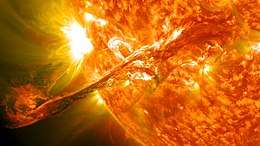
Within each orbit of the Parker Solar Probe around the Sun, the portion within 0.25 AU will be the Science Phase, in which the probe will be actively and autonomously making observations. Communication with the probe will be largely cut off in that phase.[42]:4 Science phases will run for a few days both before and after each perihelion. They will last 11.6 days for the earliest perihelion, and drop to 9.6 days for the final, closest perihelion.[42]:8
Much of the rest of each orbit will be devoted to transmitting data from the science phase. But during this part of each orbit, there will still be periods when communication is not possible. First, the heat shield of the probe must be pointed towards the Sun; there will be times when that will put the heat shield between the antenna and Earth. Second, even when the probe is not particularly near the Sun, when the angle between the probe and the Sun (as seen from Earth) is too small, the Sun's radiation will overwhelm the communication link.[42]:11–14
Science goals
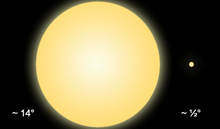
The goals of the mission are:[34]
- Trace the flow of energy that heats the corona and accelerates the solar wind
- Determine the structure and dynamics of the magnetic fields at the sources of solar wind
- Determine what mechanisms accelerate and transport energetic particles
Investigations
.jpg)
To achieve these goals, the mission will perform five major experiments or investigations:[34]
- Electromagnetic Fields Investigation (FIELDS) – This investigation will make direct measurements of electric and magnetic fields, radio waves, Poynting flux, absolute plasma density, and electron temperature. It consists of two flux-gate magnetometers, a search-coil magnetometer, and 5 plasma voltage sensors. The Principal investigator is Stuart Bale, at the University of California, Berkeley
- Integrated Science Investigation of the Sun (IS☉IS) – This investigation will measure energetic electrons, protons and heavy ions. The instrument suite comprises two independent Energetic Particle Instruments, the EPI-Hi and EPI-Lo studying higher and lower energy particles [43] The Principal investigator is David McComas, at the Princeton University
- Wide-field Imager for Solar Probe (WISPR) – These optical telescopes will acquire images of the corona and inner heliosphere. The Principal Investigator is Russell Howard, at the Naval Research Laboratory
- Solar Wind Electrons Alphas and Protons (SWEAP) – This investigation will count the electrons, protons and helium ions, and measure their properties such as velocity, density, and temperature. Its main instruments are the Solar Probe Analyzers (SPAN, two electrostatic analyzers) and the Solar Probe Cup (SPC, a Faraday cup). The Principal Investigator is Justin Kasper at the University of Michigan and the Smithsonian Astrophysical Observatory
- Heliospheric Origins with Solar Probe Plus (HeliOSPP) – A theory and modeling investigation to maximize the scientific return from the mission. The Principal Investigator is Marco Velli at UCLA and the Jet Propulsion Laboratory (JPL)
Timeline
After the first Venus flyby, the probe will be in an elliptical orbit with a period of 150 days (two-thirds the period of Venus), making three orbits while Venus makes two. On the second flyby, the period shortens to 130 days. After less than two orbits (only 198 days later) it encounters Venus a third time at a point earlier in the orbit of Venus. This encounter shortens its period to half of that of Venus, or about 112.5 days. After two orbits it meets Venus a fourth time at about the same place, shortening its period to about 102 days. After 237 days it meets Venus for the fifth time and its period is shortened to about 96 days, three-sevenths that of Venus. It then makes seven orbits while Venus makes three. The sixth encounter, almost two years after the fifth, brings its period down to 92 days, two-fifths that of Venus. After five more orbits (two orbits of Venus) it meets Venus for the seventh and last time, decreasing its period to 88 or 89 days and allowing it to approach closer to the Sun.[44]
| Year | Date | Event | Distance from Sun (Gm)a | Speed (km/s) | Orbital period (days) | Notes |
|---|---|---|---|---|---|---|
| Flyby altitude over Venus b | Leg of Parker's orbit c | Inside/Outside orbit of Venus d | ||||
| 2018 | August 12 07:31 UTC | Launch | 151.6 | – | 174e | |
| October 3 08:44 UTC | Venus flyby #1 | 2548 kmf | Inbound | Inside | Flybys 1 and 2 occur at the same point in Venus's orbit | |
| November 6 03:27 UTC | Perihelion #1 | 24.8g | 95 | 150 | Solar encounter phase October 31 – November 11[46] | |
| 2019 | April 4 22:40 UTC | Perihelion #2 | Solar encounter phase March 30 – April 10[47] | |||
| September 1 17:50 UTC[48] | Perihelion #3 | Solar encounter phase August 16 – September 20 h | ||||
| December 26 18:14 UTC[49] | Venus flyby #2 | 3023 km | Inbound | Inside | Flybys 1 and 2 occur at the same point in Venus's orbit | |
| 2020 | January 29 09:37 UTC[50] | Perihelion #4 | 19.4 | 109 | 130 | Solar encounter phase January 23 – February 29[51] |
| June 7 08:23 UTC[52] | Perihelion #5 | Solar encounter phase May 9 – June 28[53] | ||||
| July 11 03:22 UTC[54] | Venus flyby #3 | 834 km | Outbound | Outside i | Flybys 3 and 4 occur at the same point in Venus's orbit | |
| September 27 | Perihelion #6 | 14.2 | 129 | 112.5 | ||
| 2021 | January 17 | Perihelion #7 | ||||
| February 20 | Venus flyby #4 | 2392 km | Outbound | Outside | Flybys 3 and 4 occur at the same point in Venus's orbit | |
| April 29 | Perihelion #8 | 11.1 | 147 | 102 | ||
| August 9 | Perihelion #9 | |||||
| October 16 | Venus flyby #5 | 3786 km | Inbound | Inside | Flybys 5 and 6 occur at the same point in Venus's orbit | |
| November 21 | Perihelion #10 | 9.2 | 163 | 96 | ||
| 2022 | February 25 | Perihelion #11 | ||||
| June 1 | Perihelion #12 | |||||
| September 6 | Perihelion #13 | |||||
| December 11 | Perihelion #14 | |||||
| 2023 | March 17 | Perihelion #15 | ||||
| June 22 | Perihelion #16 | |||||
| August 21 | Venus flyby #6 | 3939 km | Inbound | Inside | Flybys 5 and 6 occur at the same point in Venus's orbit | |
| September 27 | Perihelion #17 | 7.9 | 176 | 92 | ||
| December 29 | Perihelion #18 | |||||
| 2024 | March 30 | Perihelion #19 | ||||
| June 30 | Perihelion #20 | |||||
| September 30 | Perihelion #21 | |||||
| November 6 | Venus flyby #7 | 317 km | Outbound | Outside | ||
| December 24 | Perihelion #22 | 6.9 | 192 | 88 | ||
| 2025 | March 22 | Perihelion #23 | ||||
| June 19 | Perihelion #24 | |||||
| September 15 | Perihelion #25 | |||||
| December 12 | Perihelion #26 |
^a The perihelion distances above are from the center of the Sun. For altitude above the surface, subtract one solar radius ≈ 0.7 Gm.
^b Details on Venus flybys from Guo et al.[42]:6 This was published in 2014, four years before the mission began. For a variety of reasons, including the fact that the launch had to be delayed at the last minute, actual details could differ from the ones presented in the work.
^c Inbound indicates that the Venus flyby will take place after Parker's aphelion (in the case of the first flyby, after its launch), on its way to perihelion. Outbound indicates that the Venus flyby will take place after Parker's perihelion, on its way to aphelion.
^d Inside indicates that the probe will pass in between Venus and the Sun. Outside indicates that the probe will pass beyond Venus from the Sun; the probe will briefly pass through Venus's shadow in those instances.
^e The first orbital period of 174 days was the orbit established by the launch and course adjustments, and was the orbit the probe would have taken had nothing further happened to change it. That orbit was, per mission plan, never completed. On the probe's first inbound course towards the Sun, it made its first planned encounter with Venus, which shortened its orbit considerably.
^f The altitude is from the source cited,[42]:6 dated 2014. 2548 km comes to 1583 mi. NASA's [55] and Johns Hopkins's [56] press releases (identical), say "...came within about 1500 miles of Venus' surface ..." A NASA blog [57] says, "...completed its flyby of Venus at a distance of about 1,500 miles ..." Other news reports, presumably taking that information, also provide a figure of 2414 km. But neither the NASA/Hopkins press release nor the blog gives a figure in kilometers.
Both the NASA and Hopkins press releases say that the flyby reduced the speed of the Parker Solar Probe (relative to the Sun) by about 10%, or 7,000 mph. This altered the orbit, bringing perihelion about 4 million miles closer to the Sun than it would have been without the gravity assist.
^g By way of comparison, the planet Mercury orbits the Sun at a distance varying from about 46.0 Gm (46,001,200 km) at its closest to about 69.8 Gm (69,816,900 km) at its farthest.
^h After the second solar encounter phase, Parker Solar Probe was able to download much more data than NASA had expected. So NASA announced a substantial extension of the third solar encounter phase from 11 days to about 35 days. The observational instruments were turned on when Parker Solar Probe came within 0.45 au on the inbound trip, and are planned to run until the probe reaches about 0.50 au outbound.[58]
^i The third flyby of Venus was the first to pass behind Venus from the point of view of the Sun. The probe was in Venus's shadow, obscured from the Sun, for about 11 minutes, and passed through a so-called "tail" of Venus--a trail of charged particles from the atmosphere of Venus. The probe's instruments were to be turned on to make observations.[54]
Operational history

- Launch occurred on August 12, 2018, at 3:31 a.m. EDT, 07:31 UTC. The spacecraft operated nominally after launching. During its first week in space it deployed its high-gain antenna, magnetometer boom, and electric field antennas.[59] The spacecraft performed its first scheduled trajectory correction on August 20, 2018, while it was 8.8 million km from Earth, and travelling at 63,569 km/h (39,500 mph) [60]
- Instrument activation and testing began in early September 2018. On September 9, the two WISPR telescopic cameras performed a successful first-light test, transmitting wide-angle images of the background sky towards the galactic center.[61]
- The probe successfully performed the first of the seven planned Venus flybys on October 3, 2018, where it came within about 2,400 kilometres (1,500 mi) of Venus in order to reduce the probe's speed and orbit closer to the Sun [57]
- The first scientific observations were transmitted in December 2018 [62][63]
- NASA announced that on January 19, 2019, the Parker Solar Probe reached its first aphelion, thus completing its first full orbit.[64] According to the Horizons system,[65] on January 20, 2019 at 01:12 UTC, the space ship reached a distance of 0.9381 au
- On November 12, 2019, the data from the first two flybys of the Sun (October 31 – November 12, 2018, and March 30 – April 19, 2019) was released to the public [66]
Findings
On December 4, 2019, the first four research papers were published describing findings during the spacecraft's first two dives near the Sun.[67][68][69][70][71] They reported the direction and strength of the Sun's magnetic field, and described the unusually frequent and short-lived changes in the direction of the Sun's magnetic field. These measurements confirm the hypothesis that Alfvén waves are the leading candidates for understanding the mechanisms that underlie the coronal heating problem.[68][72] The probe observed approximately a thousand "rogue" magnetic waves in the solar atmosphere that instantly increase solar winds by as much as 300,000 miles per hour (480,000 km/h) and in some cases completely reverse the local magnetic field.[68][69][73][74] They also reported that, using the "beam of electrons that stream along the magnetic field", they were able to observe that "the reversals in the Sun's magnetic field are often associated with localized enhancements in the radial component of the plasma velocity (the velocity in the direction away from the Sun's centre)". The researchers found a "surprisingly large azimuthal component of the plasma velocity (the velocity perpendicular to the radial direction). This component results from the force with which the Sun's rotation slingshots plasma out of the corona when the plasma is released from the coronal magnetic field".[68][69]
Parker discovered evidence of a cosmic dust free zone of 3.5 million miles (5.6 million kilometres) radius from the Sun, due to vaporisation of cosmic dust particles by the Sun's radiation.[75]
See also
- Living With a Star
- Advanced Composition Explorer – NASA scientific satellite to study energetic particles (ACE), launched 1997
- List of vehicle speed records
- Sun observation spacecraft
- Solar and Heliospheric Observatory – European space observatory studying the Sun and its solar wind; cornerstone mission in the ESA Science Programme, launched 1995
- Solar Dynamics Observatory, SDO, launched 2010
- Helios, a pair of spacecraft launched in the 1970s to approach the Sun inside the orbit of Mercury, 63 R☉
- Solar Orbiter – European solar observatory studying the Sun's heliosphere; medium-class mission in the ESA Science Programme (launched 2020), 60 R☉
- STEREO, launched 2006
- TRACE, launched 1998
- WIND, launched 1994
- Ulysses – A 1990 robotic space probe; studied the Sun from a near-polar orbit (carried no camera, and studied from 1.35 au distant)
- Spacecraft design
- Spacecraft thermal control
- MESSENGER, Mercury orbiter (2011–2015) with sun shield
- Sunshield (JWST)
Notes
- Mission planning used a perihelion of 9.5 R☉ (6.6 Gm; 4.1×106 mi), or 8.5 R☉ (5.9 Gm; 3.7×106 mi) altitude above the surface,[6] but later documents all say 9.86 R☉. The exact value will not be finalized until the seventh Venus gravity assist in 2024. Mission planners might decide to alter it slightly before then.
References
- Parker Solar Probe – Extreme Engineering. NASA.
- Chang, Kenneth (August 12, 2018). "Parker Solar Probe Launches on NASA Voyage to 'Touch the Sun'". The New York Times. Retrieved August 12, 2018.
- Chang, Kenneth (August 11, 2018). "NASA Delays Parker Solar Probe Launch". The New York Times. Retrieved August 11, 2018.
- "Parker Solar Probe Ready for Launch on Mission to the Sun". NASA. August 10, 2018. Retrieved August 10, 2018.
- Clark, Stephen (March 18, 2015). "Delta 4-Heavy selected for launch of solar probe". Spaceflight Now. Retrieved March 18, 2015.
- Applied Physics Laboratory (November 19, 2008). "Feasible Mission Designs for Solar Probe Plus to Launch in 2015, 2016, 2017, or 2018" (PDF). Johns Hopkins University. Cite journal requires
|journal=(help) - "Parker Solar Probe Science Gateway". sppgway.jhuapl.edu. Retrieved October 9, 2017.
- Clark, Stuart (July 22, 2018). "Parker Solar Probe: set the controls for the edge of the sun..." The Guardian.
- Chang, Kenneth (May 31, 2017). "Newly Named NASA Spacecraft Will Aim Straight for the Sun". New York Times. Retrieved June 1, 2017.
- "NASA Press Kit: Parker Solar Probe" (PDF). NASA. Retrieved August 15, 2018.
- "Parker Solar Probe—eoPortal Directory—Satellite Missions". directory.eoportal.org. Retrieved October 6, 2018.
- Garner, Rob (August 9, 2018). "Parker Solar Probe: Humanity's First Visit to a Star". NASA. Retrieved August 9, 2018.
- Bogel-Burroughs, Nicholas; Dunn, Marcia. "NASA probe operated from Johns Hopkins lab in Laurel rockets toward sun for closest look yet". The Baltimore Sun. Retrieved August 16, 2018.
- "NASA Renames Solar Probe Mission to Honor Pioneering Physicist Eugene Parker". NASA. May 31, 2017. Retrieved May 31, 2017.
- "NASA's Solar Parker Probe To Carry Over 1.1 Million Names To The Sun". Headlines Today. Archived from the original on August 10, 2018. Retrieved August 10, 2018.
- "NASA Press Kit: Parker Solar Probe". NASA. Retrieved August 15, 2018.
- Rogers, James (October 29, 2018). "NASA's Parker Solar Probe breaks record, becomes closest spacecraft to the Sun". Fox News.
- Frazier, Sarah. "Parker Solar Probe Reports Successful Record-Setting Fourth Close Encounter of the Sun". NASA. Retrieved February 4, 2020.
- Naugle, John E. (1991). "§3.2.2: Physics of Fields and Particles in Space". First Among Equals: The Selection of NASA Space Science Experiments (PDF). The NASA History Series. p. 34. LCCN 91-13286. NASA SP-4215.
- Bronk, Detlev W. (August 3, 1958). "National Academy of Sciences Establishes Space Science Board" (PDF) (Press release). National Academy of Sciences – National Research Council.
- McNutt, Ralph L. Jr. (December 15, 2015). Solar Probe Plus: A Scientific Investigation Sixty Years in the Making. American Geophysical Union Fall Meeting. Bibcode:2015AGUFMSH24A..01M.
- Graber-Stiehl, Ian (August 13, 2018). "A 60-year race to touch the Sun". Astronomy.
- "McNamee Chosen to Head NASA's Outer Planets/Solar Probe Projects" (Press release). Jet Propulsion Laboratory. April 15, 1998. Archived from the original on January 2, 2017. Retrieved January 2, 2017.
- Maddock, Robert W.; Clark, Karla B.; Henry, Curt A.; Hoffman, Pamela J. (March 7, 1999). The Outer Planets/Solar Probe Project: "Between an ocean, a rock, and a hot place" (PDF). 1999 IEEE Aerospace Conference. Bibcode:1999aero....1..383M.
- Berger, Brian (February 4, 2002). "NASA Kills Europa Orbiter; Revamps Planetary Exploration". Space.com. Purch Group. Archived from the original on February 10, 2002. Retrieved January 2, 2017.
- Savage, Donald (November 29, 2001). "NASA Selects Pluto–Kuiper Belt Mission Phase B Study". National Aeronautics and Space Administration (NASA). Archived from the original on July 8, 2015. Retrieved July 9, 2015.
- Hand, Eric (June 25, 2015). "Feature: How Alan Stern's tenacity, drive, and command got a NASA spacecraft to Pluto". Science (journal). American Association for the Advancement of Science. Archived from the original on June 26, 2015. Retrieved July 8, 2015.
- Fazekas, Andrew (September 10, 2010). "New NASA Probe to Dive-bomb the Sun". National Geographic. 21st Century Fox/National Geographic Society. Archived from the original on January 2, 2017. Retrieved January 2, 2017.
- Chang, Kenneth (August 10, 2018). "NASA's Parker Solar Probe Is Named for Him. 60 Years Ago, No One Believed His Ideas About the Sun. Eugene N. Parker predicted the existence of solar wind in 1958. The NASA spacecraft is the first named for a living person". The New York Times. Retrieved August 12, 2018.
- Burgess, Matt (May 31, 2017). "Nasa's mission to Sun renamed after astrophysicist behind solar wind theory". Wired. Retrieved January 1, 2018.
- How NASA's New Solar Probe Will 'Touch' the Sun on Historic Mission. Meghan Bartels, Space.com. August 9, 2018.
- Successful Launch of NASA's Parker Solar Probe. SatNews Daily. August 12, 2018.
- "Parker Solar Probe Begins Mission on Rocket Dedicated to APL's Andy Dantzler". The Johns Hopkins University Applied Physics Laboratory. September 26, 2018. Retrieved December 3, 2018.
- Fox, N.J.; Velli, M.C.; Bale, S.D.; Decker, R.; Driesman, A.; Howard, R.A.; Kasper, J.C.; Kinnison, J.; Kusterer, M.; Lario, D.; Lockwood, M.K.; McComas, D.J.; Raouafi, N.E.; Szabo, A. (November 11, 2015). "The Solar Probe Plus Mission: Humanity's First Visit to Our Star". Space Science Reviews. 204 (1–4): 7–48. Bibcode:2016SSRv..204....7F. doi:10.1007/s11214-015-0211-6. ISSN 0038-6308.
- "Solar Probe Plus: A NASA Mission to Touch the Sun". Johns Hopkins University Applied Physics Laboratory. September 4, 2010. Retrieved September 30, 2010.
- Landis, Geoffrey A.; et al. (July 28–30, 2008). Solar Power System Design for the Solar Probe+ Mission (PDF). 6th International Energy Conversion Engineering Conference. Cleveland, Ohio. AIAA 2008-5712.
- Mehar, Pranjal (July 20, 2018). "Traveling to the Sun: Why won't Parker Solar Probe melt?". Tech Explorist.
- Scharf, Caleb A. "The Fastest Spacecraft Ever?". Scientific American Blog Network.
- "Aircraft Speed Records". Aerospaceweb.org. November 13, 2014.
- "Fastest spacecraft speed". guinnessworldrecords.com. July 26, 2015. Archived from the original on December 19, 2016.
- Parker Solar Probe – Check123, Video Encyclopedia, archived from the original on August 10, 2017, retrieved June 1, 2017
- Guo, Yanping; Ozimek, Martin; Mcadams, James; Shyong, Wen-Jong (May 2014). Solar Probe Plus Mission Design Overview and Mission Profile. International Symposium on Space Flight Dynamics, at Laurel, MD. ResearchGate.
- McComas, D.J.; et al. (December 2016). "Integrated Science Investigation of the Sun (ISIS): Design of the Energetic Particle Investigation". Space Science Reviews. 204 (1–4): 187–156. Bibcode:2016SSRv..204..187M. doi:10.1007/s11214-014-0059-1.
- See data and figure at "Solar Probe Plus: The Mission". Johns Hopkins University Applied Physics Laboratory. 2017.
- "HORIZONS System". Jet Propulsion Laboratory, NASA. Data file
- "Parker Solar Probe Reports First Telemetry, Acquisition of Science Data Since Perihelion". Parker Solar Probe News Center. Johns Hopkins University Applied Physics Laboratory. November 20, 2018. Retrieved December 18, 2018.
- "NASA's Parker Solar Probe Makes Second Close Approach to Sun". Sci-News. April 18, 2019. Retrieved May 11, 2019.
- Meghan Bartels (September 1, 2019). "NASA's Daring Solar Probe Is Skimming Past the Sun Today!". Space.com. Retrieved September 2, 2019.
- "Parker Solar Probe Heads Toward Second Venus Flyby". Parker Solar Probe News Center. Johns Hopkins University Applied Physics Laboratory. November 20, 2018. Retrieved December 23, 2019. Gives the time as "1:14 p.m. EST" and the distance of the flyby as "within 1870 miles."
- "Parker Solar Probe Completes Fourth Closest Approach, Breaks New Speed and Distance Records". Parker Solar Probe News Center. Johns Hopkins University Applied Physics Laboratory. January 29, 2020. Retrieved February 21, 2020.
- "Parker Solar Probe Reports Successful Record-Setting Fourth Close Encounter of the Sun". Parker Solar Probe News Center. Johns Hopkins University Applied Physics Laboratory. February 1, 2020. Retrieved February 21, 2020.
- Bartels, Meghan (June 7, 2020). "NASA's Parker Solar Probe flies by the sun in 5th close encounter". Space.com. Future US Inc. Retrieved June 11, 2020.
- Surowiec, Justyna (May 12, 2020). "Parker Solar Probe Begins Longest Science Observation Campaign". Parker Solar Probe News Center. Johns Hopkins University Applied Physics Laboratory. Retrieved June 11, 2020.
- Bartels, Meghan (July 10, 2020). "NASA's Parker Solar Probe swings through Venus 'tail' in flyby today". Space.com. Future US Inc. Retrieved July 18, 2020.
- "Parker Solar Probe Changed the Game Before it Even Launched". Parker Solar Probe News Center. Johns Hopkins University Applied Physics Laboratory. October 4, 2018. Retrieved December 26, 2018.
- "How A Change in Mission Design Unlocked the Journey to the Sun". Parker Solar Probe Mission News. NASA. October 4, 2018. Retrieved December 26, 2018.
- "Parker Solar Probe Successfully Completes First Venus Flyby". NASA Blogs—Parker Solar Probe. NASA. October 3, 2018. Retrieved December 26, 2018.
- "Parker Solar Probe Gets Extra Observation Time". Parker Solar Probe News Center. Johns Hopkins University Applied Physics Laboratory. August 16, 2018. Retrieved September 2, 2018.
- "First milestones accomplished on NASA's newly-launched Parker Solar Probe – Spaceflight Now". spaceflightnow.com. Retrieved August 22, 2018.
- After Near-Perfect Trajectory Maneuver, Parker Solar Probe On Course To Touch The Sun. NASA. August 21, 2018.
- "Illuminating First Light Data from Parker Solar Probe". NASA Blogs: Parker Solar Probe. September 19, 2018. Retrieved September 22, 2018.
- Garner, Rob (December 12, 2018). "Preparing for Discovery With NASA's Parker Solar Probe". nasa.gov. NASA. Retrieved March 9, 2019.
- Brown, Geoffrey; Brown, Dwayne; Fox, Karen (August 12, 2018). "Parker Solar Probe Launches on Historic Journey to Touch the Sun". Parker Solar Probe. Retrieved August 13, 2018.
- "All Systems Go As Parker Solar Probe Begins Second Sun Orbit". NASA Blogs: Parker Solar Probe. January 28, 2019. Retrieved May 11, 2019.
- "HORIZONS System". Jet Propulsion Laboratory, NASA. Data file
- Bartels, Meghan. "The 1st Sun Details from NASA's Parker Solar Probe Are Out. And They're Hot!". Space.com. Retrieved December 5, 2019.
- Verscharen, Daniel (December 4, 2019). "A step closer to the Sun's secrets". Nature. 576 (7786): 219–220. doi:10.1038/d41586-019-03665-3.
- Chang, Kenneth (December 4, 2019). "NASA's Parker Solar Probe Is Unlocking the Sun's Mysteries". The New York Times. ISSN 0362-4331. Retrieved December 5, 2019.
- Kasper, J. C.; Bale, S. D.; Belcher, J. W.; Berthomier, M.; Case, A. W.; Chandran, B. D. G.; Curtis, D. W.; Gallagher, D.; Gary, S. P.; Golub, L.; Halekas, J. S. (December 4, 2019). "Alfvénic velocity spikes and rotational flows in the near-Sun solar wind". Nature. 576 (7786): 228–231. doi:10.1038/s41586-019-1813-z. hdl:10150/636481. ISSN 1476-4687.
- McComas, D. J.; Christian, E. R.; Cohen, C. M. S.; Cummings, A. C.; Davis, A. J.; Desai, M. I.; Giacalone, J.; Hill, M. E.; Joyce, C. J.; Krimigis, S. M.; Labrador, A. W. (December 4, 2019). "Probing the energetic particle environment near the Sun". Nature. 576 (7786): 223–227. doi:10.1038/s41586-019-1811-1. ISSN 1476-4687. PMC 6908744.
- Howard, R. A.; Vourlidas, A.; Bothmer, V.; Colaninno, R. C.; DeForest, C. E.; Gallagher, B.; Hall, J. R.; Hess, P.; Higginson, A. K.; Korendyke, C. M.; Kouloumvakos, A. (December 4, 2019). "Near-Sun observations of an F-corona decrease and K-corona fine structure". Nature. 576 (7786): 232–236. doi:10.1038/s41586-019-1807-x. ISSN 1476-4687.
- Bale, S. D.; Badman, S. T.; Bonnell, J. W.; Bowen, T. A.; Burgess, D.; Case, A. W.; Cattell, C. A.; Chandran, B. D. G.; Chaston, C. C.; Chen, C. H. K.; Drake, J. F. (December 4, 2019). "Highly structured slow solar wind emerging from an equatorial coronal hole". Nature. 576 (7786): 237–242. doi:10.1038/s41586-019-1818-7. hdl:11603/17219. ISSN 1476-4687.
- Witze, Alexandra (December 4, 2019). "Sun-bombing spacecraft uncovers secrets of the solar wind". Nature. 576 (7785): 15–16. doi:10.1038/d41586-019-03684-0.
- Drake, Nadia (December 4, 2019). "The sun keeps getting stranger, dive-bombing solar probe shows". National Geographic. Retrieved December 6, 2019.
- Futurism, Victor Tangermann. "Scientists 'Blown Away' by Unexpected Results From NASA's Sun-Kissing Solar Probe". ScienceAlert. Retrieved December 16, 2019.
External links
![]()
- Parker Probe Plus at Johns Hopkins University Applied Physics Laboratory (JHUAPL)
- Solar Probe Plus (Mission Engineering Report; JHUAPL)
- Heliophysics Research (NASA)
- Explorers and Heliophysics Projects Division (EHPD; NASA)
- Parker Solar Probe (data and news; NASA)
- Parker Solar Probe (Video/3:45; NYT; August 12, 2018)
- Parker Solar Probe (Video—360°/3:27; NASA; September 6, 2018)
